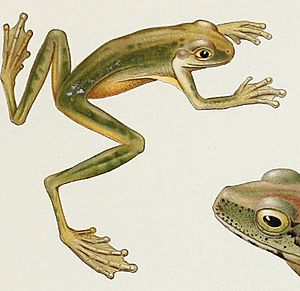Horst's tree frog facts for kids
Quick facts for kids Horst's tree frog |
|
|---|---|
 |
|
| Conservation status | |
| Scientific classification | |
| Synonyms | |
|
The Horst's tree frog (Litoria amboinensis) is a type of tree frog that lives in Papua New Guinea. These frogs have been found in the Southern Highlands Province. They live in places that are high up, from about 1,280 to 1,750 metres above sea level.
These frogs are not very big. They can grow to be about 6.5 centimetres long. People have seen them living near ponds that humans have made, often at the edges of forests. One interesting thing about them is the loud, rattling sound they make.
Contents
About Tree Frogs
Tree frogs are a special kind of frog. They spend most of their lives in trees or other tall plants. They have special pads on their toes. These pads help them climb and stick to surfaces. This allows them to live high up in the branches.
Where Horst's Tree Frogs Live
Horst's tree frogs are found only in Papua New Guinea. This country is located in Oceania, north of Australia. It has many different types of habitats. These frogs prefer areas that are quite high up in the mountains.
Their Habitat
These frogs live in forests. They are often found near water sources. People have seen them close to ponds that humans have created. This shows they can adapt to some changes in their environment. Their mountain homes are often cool and wet.
What Horst's Tree Frogs Look Like
Horst's tree frogs are medium-sized frogs. They are known for their ability to blend in with their surroundings. This helps them hide from predators. Their skin color can vary. It often matches the leaves and branches where they live.
Size and Features
As mentioned, these frogs can reach about 6.5 cm in length. Like other tree frogs, they have large eyes. Their eyes help them see well, especially at night. They also have those special toe pads. These pads are very important for their climbing lifestyle.
Sounds They Make
Horst's tree frogs are known for their loud calls. They make a distinct rattling sound. This sound is part of their communication. Male frogs often call to attract females during mating season. They might also call to warn other frogs.
Why Frogs Call
Frogs use sounds for many reasons. Their calls can tell other frogs where they are. They can also warn about danger. Different frog species have different calls. This helps them find their own kind.
Life Cycle of a Frog
Like all frogs, Horst's tree frogs go through a metamorphosis. This means they change a lot as they grow. It starts with eggs laid in water.
From Egg to Frog
- Eggs: Female frogs lay their eggs in water. The eggs are usually in a jelly-like mass.
- Tadpoles: The eggs hatch into tadpoles. Tadpoles live in water. They breathe with gills and swim using a tail. They eat algae and small plants.
- Froglets: As tadpoles grow, they start to develop legs. Their gills disappear, and lungs grow. They begin to look more like tiny frogs.
- Adult Frogs: Finally, they lose their tail completely. They become adult frogs. Adult frogs can live on land and in water. They are ready to reproduce and start the cycle again.
Conservation Status
The Horst's tree frog is listed as "Least Concern" (LC) by the IUCN Red List. This means that their population is stable. They are not currently facing a high risk of extinction. This is good news for these unique frogs.
See also
 In Spanish: Litoria amboinensis para niños
In Spanish: Litoria amboinensis para niños


